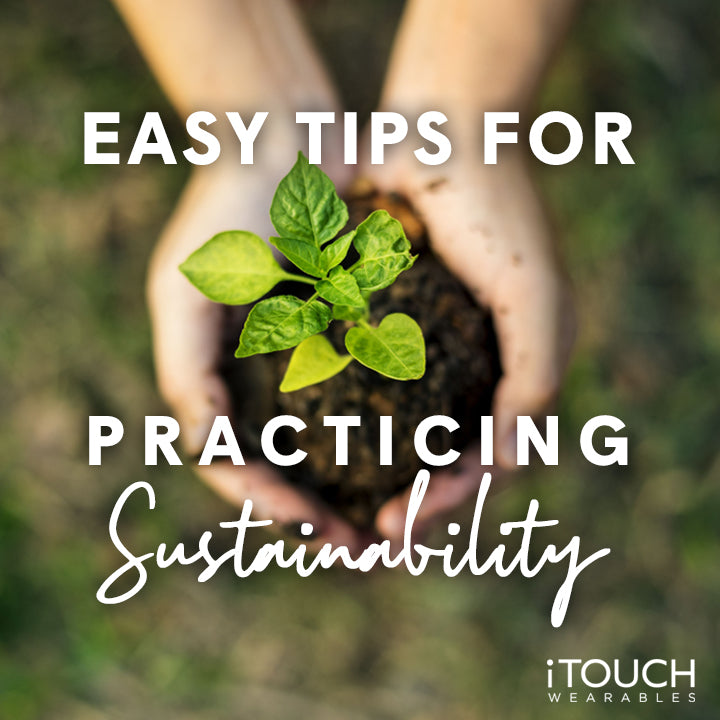
Easy Tips for Practicing Sustainability
Practicing sustainability does not have to be a daunting task. With the uprising about the ecological and environmental impact we has a country and society has produced, the importance of making strides to improve our carbon footprint and reduce our waste is more crucial than ever. In an attempt to go green, there are many easy tips for incorporating a greener lifestyle within your lives. These are our tips for practicing sustainability:
Save Water

The EPA has reported that the average American family wastes over 300 gallons of water every day. With climate changes being a major issue within the United States over the past fews, the importance to save water and be mindful of the amount of water we use is more critical than ever. While US water is safe to drink for most individuals within the United States, toxic runoff from industries, agricultural practices, fossil fuels, and degraded pipe-lines have resulted in putting thousands of communities at risk. Be cautious with how you use water, be carefully when pouring chemicals down the drain, and learn to conserve water whenever you can.
Recycle

Recycling is one of the most important tips in practicing a sustainable lifestyle. In stead of just simply throwing away old items, see if there is a way to recycle and reuse these products - analyzing the mantra "Reduce, Reuse, Recycle." Be aware of the carbon footprint you are making, and see if there are innovative new ways to use these products. Recycling helps reduce the amount of energy needed to destroy the waste created, decreasing the amount of emissions that are produced in order to do so. Try to avoid single-use items whenever you can - especially those that cannot be recycled for future use.
Practice Creating A Greener Closet

It is no news now about the effects "fast fashion" has on our environment. Brands like H&M, Zara, and Forever 21 have been deemed in producing an increasing amount of waste that have impacted our ecological and environmental footprint drastically. For example, making one pair of jeans creates more carbon emissions than driving a car for 80miles. It also takes about 2,700 liters of water to make one cotton shirt - that is nearly enough water to sustain a person for two-and-a-half years. By being conscious of the clothes you are purchasing, especially the amount of times you are buying clothing, can be critical in aiding in our environment. There are many ways to create a greener closet:
- Thrift or Buy Vintage - Thrifting and buying vintage clothing is a great way to create a greener closet. Buying high-quality thrifted pieces allows you to not only reduce the amount of clothing that winds up in landfills, but allows you to find unique, one-of-a-kind pieces that not everyone as.
- Create A Capsule Closet - Capsule Closets do not have to simply be a trend, but rather can be an effective way for creating a sustainable lifestyle. A capsule closet usually utilizes about 20 to 30 articles of clothings (including shoes and accessories) that are often rotated throughout the week to create different outfits. The are made from high-quality basics, with some fashionable trendy pieces added in. Capsule Closets are designed to last longer, be more efficient in creating outfit choices, and help in creating a minimalist lifestyle that keeps the amount of clothing you have in check.
Grow Your Own Garden

Growing your own garden that contains fruits and vegetables is an easy and fun way to create a more sustainable lifestyle. Growing your own food does not only simply aid in manifesting healthier choices within your diet, but can also aid in reducing the carbon footprint made by purchasing pre-packaged foods - one of the worst proprietors to climate change and environmental issues. Food that is often transported to supermarkets are not sourced ethically and sustainably, and can result in producing large amounts of emissions and waste. However, growing your own garden does not only help reduce those emissions, but also helps in improving the environment within your surroundings, creating healthier soil through acts of composting and regenerative gardening
Reduce Your Energy Use At Home

Doing your part to reduce the amount of energy you use at home can be an effective way to help out environment. Choosing lamps and lights that are energy efficient are a great first step, while also adding CFL (compact fluorescent lights) using about 25% of energy that other lights use. However, they cannot be thrown in the trash but rather can be recycled. Other small practices to use at home can be turning the lights off when you leave a room or even decreasing the amount of electronics you use at once.
Whether you just practice one of these tips, you can do your part to help our environment and improve our ecological footprint. Share with us your favorite sustainability tips by tagging us on Instagram @itouchwearables and Facebook @itouchwearables. Also, be sure to check out our new articles published daily!
-Patrick


